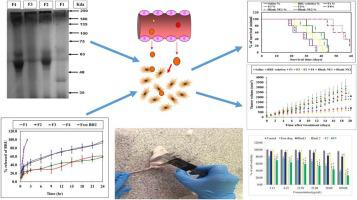当前位置:
X-MOL 学术
›
Colloids Surf. A Physicochem. Eng. Aspects
›
论文详情
Our official English website, www.x-mol.net, welcomes your
feedback! (Note: you will need to create a separate account there.)
Brucine PEGylated Nanoemulsion: In vitro and In vivo Evaluation
Colloids and Surfaces A: Physicochemical and Engineering Aspects ( IF 4.9 ) Pub Date : 2021-01-01 , DOI: 10.1016/j.colsurfa.2020.125618 Heba S. Elsewedy , Bandar E. Aldhubiab , Mahmoud A. Mahdy , Hanan M. Elnahas
Colloids and Surfaces A: Physicochemical and Engineering Aspects ( IF 4.9 ) Pub Date : 2021-01-01 , DOI: 10.1016/j.colsurfa.2020.125618 Heba S. Elsewedy , Bandar E. Aldhubiab , Mahmoud A. Mahdy , Hanan M. Elnahas

|
Abstract Cancer represents one of the most life threatening disease worldwide. Poly ethylene glycol nanoemulsion (PEG-NE), a new drug delivery system (DDS) is widely utilized for encapsulating water insoluble drugs and delivering it into cancerous tissue following its intravenous injection. Brucine (BRU) is an effective anti-carcinogenic agent toward different cancer cell lines; however, its low solubility represents a great obstacle in its formulation. The objective of this investigation was to develop and evaluate BRU-PEG-NE. Physicochemical evaluation including, viscosity, particle size and entrapment efficiency investigations were performed. Quantitative and qualitative estimation of total serum protein adsorbed onto the surface of BRU-NE were performed. in vitro release studies of BRU-NE with and without serum incubation were assayed. Formulations were tested for their cytotoxic activity using MTT assay. Finally, in-vivo anticancer effect was evaluated in tumor-inoculated mice. Homogenous NEs were obtained with particle size less than 140 nm and viscosity less than 3.3 cP for BRU-PEG-NE. Total serum protein adsorbed was less than 17.33 ± 0.76 μg/μmol total lipid for BRU-PEG-NE. in vitro drug release was less than 65 % over 24 h for PEG-NE. As well, PEG-NEs could achieve significant inhibition for the viability of cancer cells. Finally, significant reduction in tumor growth rate and mortality rate for BRU PEG-NE formulations were obtained. The obtained results suggested that BRU PEG NE could be considered as a potential mean for cancer therapy.
中文翻译:

Brucine PEGylated 纳米乳剂:体外和体内评价
摘要 癌症是全世界最危及生命的疾病之一。聚乙二醇纳米乳剂 (PEG-NE) 是一种新的药物递送系统 (DDS),广泛用于包封水不溶性药物,并在静脉注射后将其递送到癌组织中。Brucine (BRU) 是一种针对不同癌细胞系的有效抗癌剂;然而,它的低溶解度是其配方的一大障碍。本次调查的目的是开发和评估 BRU-PEG-NE。进行了物理化学评价,包括粘度、粒度和截留效率研究。对吸附在 BRU-NE 表面上的总血清蛋白进行了定量和定性评估。测定了有和没有血清孵育的 BRU-NE 的体外释放研究。使用MTT测定法测试制剂的细胞毒活性。最后,在接种肿瘤的小鼠中评估了体内抗癌作用。对于 BRU-PEG-NE,获得了粒径小于 140 nm 且粘度小于 3.3 cP 的均质 NE。对于 BRU-PEG-NE,吸附的总血清蛋白小于 17.33 ± 0.76 μg/μmol 总脂质。PEG-NE 的体外药物释放在 24 小时内低于 65%。同样,PEG-NEs 可以显着抑制癌细胞的活力。最后,获得了 BRU PEG-NE 制剂的肿瘤生长率和死亡率的显着降低。获得的结果表明 BRU PEG NE 可被视为癌症治疗的潜在手段。对于 BRU-PEG-NE,获得了粒径小于 140 nm 且粘度小于 3.3 cP 的均质 NE。对于 BRU-PEG-NE,吸附的总血清蛋白小于 17.33 ± 0.76 μg/μmol 总脂质。PEG-NE 的体外药物释放在 24 小时内低于 65%。同样,PEG-NEs 可以显着抑制癌细胞的活力。最后,获得了 BRU PEG-NE 制剂的肿瘤生长率和死亡率的显着降低。获得的结果表明 BRU PEG NE 可被视为癌症治疗的潜在手段。对于 BRU-PEG-NE,获得了粒径小于 140 nm 且粘度小于 3.3 cP 的均质 NE。对于 BRU-PEG-NE,吸附的总血清蛋白小于 17.33 ± 0.76 μg/μmol 总脂质。PEG-NE 的体外药物释放在 24 小时内低于 65%。同样,PEG-NEs 可以显着抑制癌细胞的活力。最后,获得了 BRU PEG-NE 制剂的肿瘤生长率和死亡率的显着降低。获得的结果表明 BRU PEG NE 可被视为癌症治疗的潜在手段。PEG-NEs 可以显着抑制癌细胞的活力。最后,获得了 BRU PEG-NE 制剂的肿瘤生长率和死亡率的显着降低。获得的结果表明 BRU PEG NE 可被视为癌症治疗的潜在手段。PEG-NEs 可以显着抑制癌细胞的活力。最后,获得了 BRU PEG-NE 制剂的肿瘤生长率和死亡率的显着降低。获得的结果表明 BRU PEG NE 可被视为癌症治疗的潜在手段。
更新日期:2021-01-01
中文翻译:

Brucine PEGylated 纳米乳剂:体外和体内评价
摘要 癌症是全世界最危及生命的疾病之一。聚乙二醇纳米乳剂 (PEG-NE) 是一种新的药物递送系统 (DDS),广泛用于包封水不溶性药物,并在静脉注射后将其递送到癌组织中。Brucine (BRU) 是一种针对不同癌细胞系的有效抗癌剂;然而,它的低溶解度是其配方的一大障碍。本次调查的目的是开发和评估 BRU-PEG-NE。进行了物理化学评价,包括粘度、粒度和截留效率研究。对吸附在 BRU-NE 表面上的总血清蛋白进行了定量和定性评估。测定了有和没有血清孵育的 BRU-NE 的体外释放研究。使用MTT测定法测试制剂的细胞毒活性。最后,在接种肿瘤的小鼠中评估了体内抗癌作用。对于 BRU-PEG-NE,获得了粒径小于 140 nm 且粘度小于 3.3 cP 的均质 NE。对于 BRU-PEG-NE,吸附的总血清蛋白小于 17.33 ± 0.76 μg/μmol 总脂质。PEG-NE 的体外药物释放在 24 小时内低于 65%。同样,PEG-NEs 可以显着抑制癌细胞的活力。最后,获得了 BRU PEG-NE 制剂的肿瘤生长率和死亡率的显着降低。获得的结果表明 BRU PEG NE 可被视为癌症治疗的潜在手段。对于 BRU-PEG-NE,获得了粒径小于 140 nm 且粘度小于 3.3 cP 的均质 NE。对于 BRU-PEG-NE,吸附的总血清蛋白小于 17.33 ± 0.76 μg/μmol 总脂质。PEG-NE 的体外药物释放在 24 小时内低于 65%。同样,PEG-NEs 可以显着抑制癌细胞的活力。最后,获得了 BRU PEG-NE 制剂的肿瘤生长率和死亡率的显着降低。获得的结果表明 BRU PEG NE 可被视为癌症治疗的潜在手段。对于 BRU-PEG-NE,获得了粒径小于 140 nm 且粘度小于 3.3 cP 的均质 NE。对于 BRU-PEG-NE,吸附的总血清蛋白小于 17.33 ± 0.76 μg/μmol 总脂质。PEG-NE 的体外药物释放在 24 小时内低于 65%。同样,PEG-NEs 可以显着抑制癌细胞的活力。最后,获得了 BRU PEG-NE 制剂的肿瘤生长率和死亡率的显着降低。获得的结果表明 BRU PEG NE 可被视为癌症治疗的潜在手段。PEG-NEs 可以显着抑制癌细胞的活力。最后,获得了 BRU PEG-NE 制剂的肿瘤生长率和死亡率的显着降低。获得的结果表明 BRU PEG NE 可被视为癌症治疗的潜在手段。PEG-NEs 可以显着抑制癌细胞的活力。最后,获得了 BRU PEG-NE 制剂的肿瘤生长率和死亡率的显着降低。获得的结果表明 BRU PEG NE 可被视为癌症治疗的潜在手段。











































 京公网安备 11010802027423号
京公网安备 11010802027423号